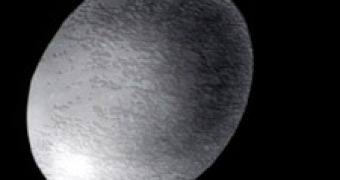Astronomers have found a strange object roaming in space beyond Neptune, in the region known as the Kuiper Belt. It is a fairly large rock with an odd shape and spinning incredibly fast. In fact, it is the fastest spinning object in the Solar System larger than 100 kilometers. But 2003 EL61, the name of the object, is much larger than that: it is at least 1,960 x 1,500 x 1,000 kilometers. See an animation of its rotation created by Michael E. Brown from Caltech.
Why is it spinning so fast? The only plausible answer is that it was hit by another body coming very fast and that the collision produced the fast spinning body as well as creating its two satellites.
This is where the story gets really interesting. Kristina Barkume from Caltech has been analyzing various Kuiper Belt Objects (KBOs) with sizes between 500 and 1000 kilometers in diameter. Due to the fact that various materials absorb different wavelengths of light we can deduce the chemical composition of distant objects by analyzing the spectrum of the light coming from them (solar light reflected by them back to us). That's exactly what Barkume has been doing.
She found that most KBOs have little water ice. But some do and 5 of the objects showing similar spectral characteristics, in particular the unusual fact that they have water ice, also share similar orbits around the Sun. This indicates that they have a common origin, probably the braking apart of some larger body in a collision.
"They have much stronger absorptions of water ice than all the KBOs for which we have data," says Barkume. "In particular, a majority of KBOs have no detectable water ice."
But here's the surprise: 2003 EL61's largest moon also has the same spectral characteristics. This means that, probably, the same collision that produced its satellites and started its crazy spin also spawned into space other bodies.
"The conclusion is that when the parent, 2003 EL61, got hit, it spewed fragments - a KBO family," wrote David Tytell from the Sky & Telescope. "The parent body is a remnant rocky core, and the children look alike."
Barkume speculates that the reason why these bodies still have water ice on them, unlike most KBOs, is that the collision was relatively recent. "We can't say its age at the moment," Bakume said, but the fact that it has so much ice might mean that this event didn't happen very long ago in geological terms.

 14 DAY TRIAL //
14 DAY TRIAL //